SLUSC27C April 2015 – March 2017
PRODUCTION DATA.
- 1 Features
- 2 Applications
- 3 Description
- 4 Revision History
- 5 Pin Configuration and Functions
- 6 Specifications
-
7 Detailed Description
- 7.1 Overview
- 7.2 Functional Block Diagram
- 7.3 Feature Description
- 7.4 Device Functional Modes
- 7.5 Programming
- 7.6
Register Maps
- 7.6.1 Battery-Charger Commands
- 7.6.2 Setting Charger Options
- 7.6.3 ChargeOption1 Register
- 7.6.4 ChargeOption2 Register
- 7.6.5 ChargeOption3 Register
- 7.6.6 ProchotOption0 Register
- 7.6.7 ProchotOption1 Register
- 7.6.8 ProchotStatus Register
- 7.6.9 Setting the Charge Current
- 7.6.10 Setting the Charge Voltage
- 7.6.11 Setting Input Current
- 7.6.12 Setting the Discharge Current
- 8 Application and Implementation
- 9 Power Supply Recommendations
- 10Layout
- 11Device and Documentation Support
- 12Mechanical, Packaging, and Orderable Information
6 Specifications
6.1 Absolute Maximum Ratings
over operating free-air temperature range (unless otherwise noted)(1)(2)| MIN | MAX | UNIT | ||
|---|---|---|---|---|
| Voltage | SRN, SRP, ACN, ACP, CMSRC, VCC, BATSRC | –0.3 | 30 | V |
| PHASE | –2 | 30 | ||
| ACDET, SDA, SCL, LODRV, REGN, IADP, IDCHG, PMON, ILIM, ACOK, CMPIN, CMPOUT, BATPRES, TB_STAT | –0.3 | 7 | ||
| PROCHOT | –0.3 | 5.7 | ||
| BTST, HIDRV, ACDRV, BATDRV | –0.3 | 36 | ||
| Differential voltage | BTST-PHASE, HIDRV-PHASE ACDRV-CMSRC, BATDRV-BATSRC | –0.3 | 7 | V |
| Voltage | LODRV (2% duty cycle) | –4 | 7 | V |
| HIDRV (2% duty cycle) | –4 | 36 | ||
| Voltage | PHASE (2% duty cycle) | –4 | 30 | V |
| Voltage | REGN (5ms) | –0.3 | 9 | V |
| Maximum differential voltage | SRP–SRN, ACP–ACN | –0.5 | +0.5 | V |
| Junction temperature, TJ | –40 | 155 | °C | |
| Storage temperature, Tstg | –55 | 155 | °C | |
(1) Stresses beyond those listed under absolute maximum ratings may cause permanent damage to the device. These are stress ratings only, and functional operation of the device at these or any other conditions beyond those indicated under recommended operating conditions is not implied. Exposure to absolute-maximum-rated conditions for extended periods may affect device reliability.
(2) All voltages are with respect to GND if not specified. Currents are positive into, negative out of the specified pin. Consult Packaging Section of the data book for thermal limitations and considerations of packages.
6.2 ESD Ratings
| VALUE | UNIT | |||
|---|---|---|---|---|
| V(ESD) | Electrostatic discharge | Human body model (HBM), per ANSI/ESDA/JEDEC JS-001 (1) | ±2000 | V |
| Charged device model (CDM), per JEDEC specification JESD22-C101 (2) | ±500 | |||
(1) JEDEC document JEP155 states that 500-V HBM allows safe manufacturing with a standard ESD control process.
(2) JEDEC document JEP157 states that 250-V CDM allows safe manufacturing with a standard ESD control process.
6.3 Recommended Operating Conditions
over operating free-air temperature range (unless otherwise noted)| MIN | MAX | UNIT | ||
|---|---|---|---|---|
| Voltage | SRN, SRP, ACN, ACP, CMSRC, VCC, BATSRC | 0 | 24 | V |
| PHASE | –2 | 24 | ||
| ACDET, SDA, SCL, LODRV, REGN, IADP, IDCHG, PMON, ILIM, ACOK, CMPIN, CMPOUT, BATPRES, TB_STAT | 0 | 6.5 | ||
| PROCHOT | –0.3 | 5 | ||
| BTST, HIDRV, ACDRV, BATDRV | 0 | 30 | ||
| Maximum difference | SRP–SRN, ACP–ACN | –0.4 | +0.4 | V |
| Junction temperature, TJ | –20 | 125 | °C | |
| Operating free-air temperature, TA | –40 | 85 | ||
6.4 Thermal Information
| THERMAL METRIC(1) | bq24780S | UNIT | |
|---|---|---|---|
| RUY (WQFN) | |||
| 28 PINS | |||
| RθJA | Junction-to-ambient thermal resistance | 33.3 | °C/W |
| RθJCtop | Junction-to-case (top) thermal resistance | 29.7 | °C/W |
| RθJB | Junction-to-board thermal resistance | 6.5 | °C/W |
| ψJT | Junction-to-top characterization parameter | 0.3 | °C/W |
| ψJB | Junction-to-board characterization parameter | 6.5 | °C/W |
| RθJCbot | Junction-to-case (bottom) thermal resistance | 1.3 | °C/W |
(1) For more information about traditional and new thermal metrics, see the IC Package Thermal Metrics application report, SPRA953.
6.5 Electrical Characteristics
4.5 V ≤ VVCC ≤ 24 V, –40°C ≤ TJ ≤ 125°C, typical values are at TA = 25°C, with respect to GND (unless otherwise noted)6.6 Timing Requirements
4.5 V ≤ VVCC ≤ 24 V, –40°C ≤ TJ ≤ 125°C, typical values are at TA = 25°C, with respect to GND (unless otherwise noted)| PARAMETER | MIN | TYP | MAX | UNIT | ||
|---|---|---|---|---|---|---|
| ACOK COMPARATOR | ||||||
| tACOK_RISE_DEG | ACOK rising deglitch to turn on ACFET; VACDET > 2.4V [GBD] |
VVCC > VVCC_UVLO, ACDET ramps up, 1st time or REG0x12[12] = 0 |
100 | 150 | 200 | ms |
| VVCC > VVCC_UVLO, ACDET ramps up, Not 1st time or REG0x12[12] = 1 |
0.9 | 1.3 | 1.7 | s | ||
| tACOK_FALL_DEG | ACOK falling deglitch to turn off ACFET [GBD] |
VVCC > VVCC_UVLO, ACDET ramps down | 3 | µs | ||
| INPUT OVERCURRENT COMPARATOR (ACOC) | ||||||
| tACOC_DEG | Deglitch time to latch off ACFET | 9 | 12 | 15 | ms | |
| SMBus TIMING CHARACTERISTICS | ||||||
| tR | SCLK/SDATA rise time | 1 | µs | |||
| tF | SCLK/SDATA fall time | 300 | ns | |||
| tW(H) | SCLK pulse width high | 4 | 50 | µs | ||
| tW(L) | SCLK pulse width low | 4.7 | µs | |||
| tSU(STA) | Setup time for start condition | 4.7 | µs | |||
| tH(STA) | Start condition hold time after which first clock pulse is generated | 4 | µs | |||
| tSU(DAT) | Data setup time | 250 | ns | |||
| tH(DAT) | Data hold time | 300 | ns | |||
| tSU(STOP) | Setup time for stop condition | 4 | µs | |||
| t(BUF) | Bus free time between start and stop condition | 4.7 | µs | |||
| FS(CL) | Clock frequency | 10 | 100 | kHz | ||
| HOST COMMUNICATION FAILURE | ||||||
| ttimeout | SMBus bus release timeout(1) | 25 | 35 | ms | ||
| tBOOT | Deglitch for watchdog reset signal | 10 | ms | |||
| tWDI | Watchdog timeout period, REG0x12 [14:13] = 01(2) | 4 | 5 | 6 | s | |
| tWDI | Watchdog timeout period, REG0x12 [14:13] = 10(2) | 70 | 88 | 105 | ||
| tWDI | Watchdog timeout period, REG0x12 [14:13] = 11(2) (default) | 140 | 175 | 210 | ||
| PWM DRIVER TIMING | ||||||
| tDEADTIME_RISE | Driver dead time from low side to high side | 20 | ns | |||
| tDEADTIME_FALL | Driver dead time from high side to low side | 20 | ns | |||
(1) Devices participating in a transfer timeout when any clock low exceeds the 25-ms minimum timeout period. Devices that have detected a timeout condition must reset the communication no later than the 35-ms maximum timeout period. Both a master and a slave must adhere to the maximum value specified because it incorporates the cumulative stretch limit for both a master (10 ms) and a slave (25 ms).
(2) User can adjust threshold through SMBus ChargeOption() REG0x12.
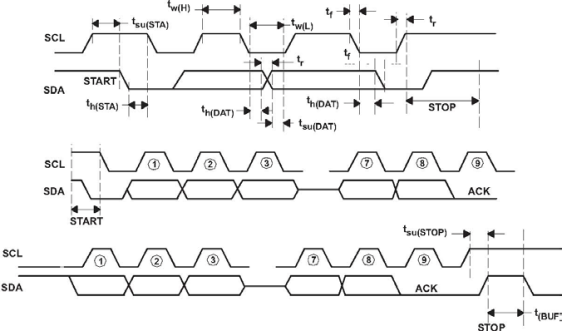 Figure 1. SMBus Communication Timing Waveforms
Figure 1. SMBus Communication Timing Waveforms
6.7 Typical Characteristics
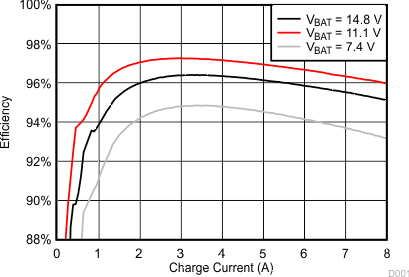
| VIN = 20 V | ||
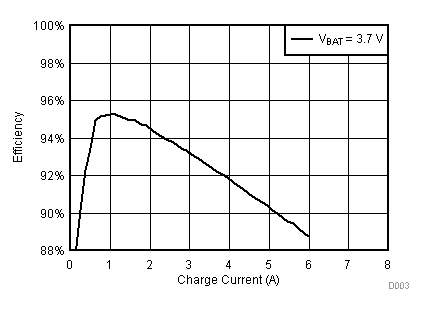
| VIN = 5 V | ||
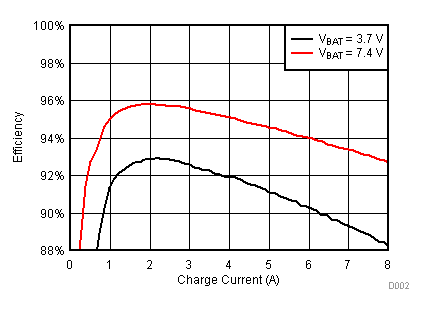
| VIN = 12 V | ||
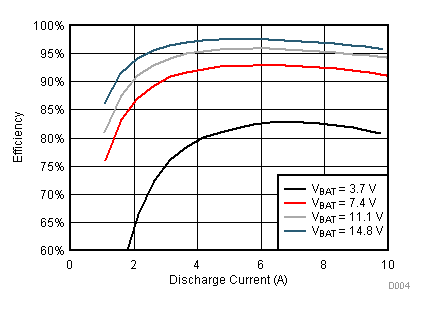
| VIN = 20 V | ||